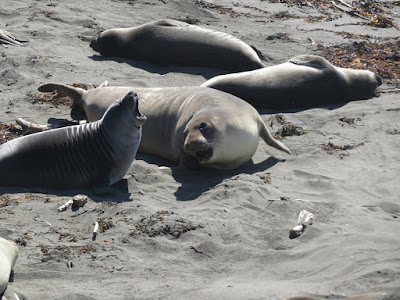 |
| Juvenile Elephant Seal |
We were advised, “You need to go see the elephant seals
when you are up that way.” And so, we
did. The Elephant Seal Vista spot is
about 5 miles north of the tiny hamlet of San Simeon on the Central California
Coast. As we pulled into the parking lot,
we noticed a beach full of grey and brown driftwood. Huge logs, that turned out to be hundreds of
elephant seals taking naps.
 |
| That's alotta seals |
 |
| As far as the eyes can see |
The elephant seals were hunted almost to extinction for their
valuable blubber. A tiny colony was
found and protected on an island off of the coast of southern California. Slowly they multiplied, and in 1990 a few arrived
on this beach to deliver pups, breed and to molt. Those few have expanded to 1,500 individuals
who return year after year.
For eight to ten months of the year, elephant seals lead
solitary lives out in the ocean. They
fish and forage and are capable of diving to great depths. They swim and dive twenty-four hours a day. They return to land for brief visits twice a
year. They fast while they are on land,
and lose a lot of weight. Consequently,
they don’t move around very much when they are on land, to save energy.
 |
| Back feet/flippers |
 |
| Molting |
In December the males arrive to assert dominance over a
particular section of beach. Pregnant
females arrive shortly thereafter in January, and have their pups. The pup weighs about 70 pounds. The pups nurse for four weeks quadrupling
their weight. The female mates, weans
her pup and returns to the sea alone. The
pups are left to learn how to swim and fend for themselves. When the females leave, so do the males.
 |
| Out in the surf |
In March, the females and juveniles, who have been at sea
all winter, return to undergo a “catastrophic molt” where they grow a new layer
of skin and hair and shed the old skin and hair. It is this moth-eaten crew that we saw. They grunted and snorted and growled at each
other. They flipped sand on their backs,
humans have theories, but are not really sure why they do that. Occasionally one would move from place to
place, and juveniles jousted out in the water.
The vista for viewing these amazing, enormous creatures is
a long boardwalk along the top of the cliff overlooking the beach. Volunteers in blue jackets are on hand to
answer questions, and informational signs tell you more about the rookery and
elephant seals. It was a privilege to
see these animals up close.
 |
| Happy Sealwatchers |
 |
The coastline in this part of California
|













No comments:
Post a Comment